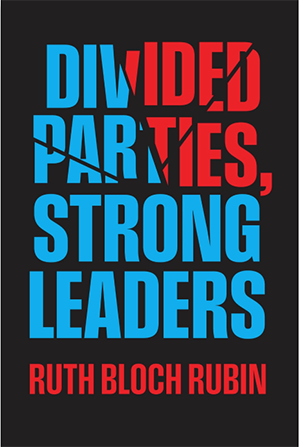How a party’s factions are organized will determine congressional leaders’ power
A new book by Ruth Bloch Rubin argues that party divisions aren’t inherently limiting
By Sarah Steimer

Both popular and academic observers of Congress have long thought that party divisions profoundly constrain congressional leaders. But a new book by Associate Professor of Political Science Ruth Bloch Rubin argues that party divisions are not inherently limiting. Drawing on nearly a century of legislative history, Divided Parties, Strong Leaders finds that party heads are sometimes able to overcome members’ disagreement to wield significant power over congressional affairs. The book explains when and why this happens, challenging existing theories of party power along the way.
“The conventional wisdom is that you'll have strong leaders when a party is unified—that is, when members are in line ideologically—and weak leaders when a party is divided—when there’s more disagreement,” Bloch Rubin says. “But what I find is that this just does not fit the empirical reality.”
Traditionally, scholars have thought that party divisions reflect underlying disagreements about the substance of politics. The more members of the same party disagree with each other about a particular policy or procedural question, the more divided the party. But Bloch Rubin argues that there is more to party divisions than members’ beliefs about what the world should look like — what political scientists call their ideological preferences. Bloch Rubin also refers to a collaborative dimension of party divisions: Distinct from the ideological dimension of politics, the collaborative dimension maps the choice every member makes about whether to pursue their goals independently or instead to join forces with like-minded co-partisans to get their way. Sometimes, multiple members who agree with each other about something — what she calls a faction — will work closely together; other times they won’t.
Bloch Rubin suggests that these choices create a collaborative landscape that shapes leader power. “The big idea is that we can describe parties in terms of collaborative configurations,” she says. “Sometimes leaders are going to govern parties that are asymmetrically divided, that is a party where only one faction is working together. But leaders can also confront a symmetrically divided party, where all factions are collaborating on roughly equal terms.” The contemporary Republican conference is an example of an asymmetric division. Conservative Republicans are well organized, engage with each other, and work together quite regularly. Moderate Republicans, by contrast, have been unwilling to do the same.
According to Bloch Rubin, leaders are generally able to get more of what they want under conditions of party symmetry than under conditions of party asymmetry.
Thinking about politics in this way, she notes, can help us to understand why recent congresses have seen so much variation in how leaders of divided parties perform. “Nancy Pelosi governed her party for almost 20 years, and as Speaker, racked up a ton of legislative accomplishments,” Bloch Rubin says. “Given her longevity and record of success, she is rightly perceived by both Republicans and Democrats as one of the most powerful speakers of all time. But it is notable that her Republican counterparts, from John Boehner to Mike Johnson, have really struggled. The challenge for political scientists is that we can’t just blame polarization or party divisions for their trouble, because Pelosi dealt with a polarized Congress and her House Democrats were divided, too.”

For Bloch Rubin, the key is that Pelosi’s party grew more symmetric over the past decade. While moderate House Democrats have long collaborated extensively, progressives have significantly augmented their collaborative efforts. Republican leaders have been less fortunate. While members of the party’s right flank work well together, Republican moderates have generally shunned the kinds of collaborative activities that would allow them to act as an effective counterweight. The result is that Republican leaders have routinely found they are at the mercy of their most conservative members.
It is quite common today to read arguments that the contemporary Congress operates much differently than in the past. But better understanding how members’ collaborative choices structure leadership in Congress can also help us to see deep continuities in Congress’s institutional structure, Bloch Rubin says.
“It is really tempting to think that everything about our present politics is new or a major break from the past, but these collaborative dynamics are timeless,” she says. “Yes, different periods in time present their own governance challenges, but the core organizational logics that structure legislative life matter for leaders across time in ways that are unchanging.”
In addition to the more current examples of Pelosi, Boehner, and Johnson, Bloch Rubin also reflects on the careers of legendary leaders like Sam Rayburn, who was the longest serving speaker in American history, and Tip O’Neill, who is credited with being the first modern speaker to govern in an era of real transparency and sharpened inter-party disagreement.
“By revisiting these important leaders and showing that we can understand their performance on the basis of their parties’ collaborative dynamics, I think it provides additional evidence that there are real analytic payoffs to thinking about legislative politics in the ways that I'm encouraging readers to do,” Bloch Rubin says.
In addition to reaching political scientists, Bloch Rubin hopes the book will be read by both citizens and reformers.
“One lesson from this book is that voters shouldn’t assume that the lawmakers chosen to lead divided parties can’t govern their members well,” she says. “I show that leaders have some agency in moving an asymmetrically divided party into a party that has greater symmetry. So, if voters are upset that Republican leaders in Congress today aren’t delivering on their party’s campaign promises, they should hold them accountable for not doing more to support collaboration among their party’s remaining moderates. Because doing that would make it easier for them, as leaders, to do their jobs and to fulfill their constitutional duties to the American public.”
She says a similar lesson applies for reformers who are unhappy with how polarized congressional politics has become. For reformers concerned about the influence of extremists in Congress, Bloch Rubin recommends that they invest their resources in helping Congress’s existing moderates to work together productively. This won’t be easy, she acknowledges, but it is far harder to recruit moderate candidates to run for Congress or to raise enough money so that they win. In a moment where resources are finite, Bloch Rubin argues, reformers would do well to work with what they have.
 THE UNIVERSITY OF CHICAGO
THE UNIVERSITY OF CHICAGO

